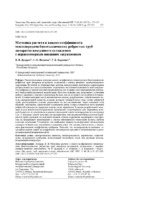| dc.contributor.author | Дударев, В. В. | ru |
| dc.contributor.author | Филатов, С. О. | ru |
| dc.contributor.author | Карлович, Т. Б. | ru |
| dc.coverage.spatial | Минск | ru |
| dc.date.accessioned | 2017-05-17T10:27:27Z | |
| dc.date.available | 2017-05-17T10:27:27Z | |
| dc.date.issued | 2017 | |
| dc.identifier.citation | Дударев, В. В. Методика расчета и анализ коэффициента теплопередачи биметаллических ребристых труб аппаратов воздушного охлаждения с неравномерным внешним загрязнением = The Method of Calculation and Analysis of Heat Transfer Coefficient of Bimetallic Finned Tubes of Air Cooling Units with Irregular External Contamination / В. В. Дударев, С. О. Филатов, Т. Б. Карлович // Энергетика. Известия высших учебных заведений и энергетических объединений СНГ. – 2017. – № 3. – С. 237-255. | ru |
| dc.identifier.uri | https://rep.bntu.by/handle/data/29930 | |
| dc.description.abstract | Рассмотрена новая методика расчета коэффициента теплопередачи биметаллических ребристых труб аппаратов воздушного охлаждения с учетом внешнего эксплуатационного загрязнения. В отличие от общеизвестных методик, использующих допущение о равномерном распределении слоя эксплуатационного загрязнения с постоянной толщиной по всей поверхности оребрения, в данной методике предполагается, что толщина слоя загрязнения при длительной эксплуатации изменяется неравномерно. При этом толщина слоя загрязнения у основания ребер со временем становится значительно больше, чем на остальной части ребристой поверхности. В основе методики лежит математическая модель, разработанная с использованием метода электротепловой аналогии, согласно которому тепловой поток через стенку ребристой трубы рассматривается условно разделенным на две составляющие: через кольцевой слой внешнего загрязнения, прилегающий к основанию ребер, и через оставшуюся часть внешней ребристой поверхности, покрытую тонким слоем загрязнения. В рамках разработанной методики создан новый способ определения термического сопротивления слоя загрязнения, который базируется на аналитическом решении двухмерной задачи теплопроводности в кольцевом слое. С помощью данной методики для промышленно изготавливаемой биметаллической ребристой трубы проведено исследование влияния степени загрязнения межреберного пространства на коэффициент теплопередачи с учетом интенсивности теплоотдачи воздуха, свойств и состава загрязнения. Установлено, что наибольшее влияние на коэффициент теплопередачи оказывает толщина слоя загрязнения у основания ребер. Это связано, прежде всего, с изменением фактического коэффициента оребрения. Показано, что теплопроводность внешнего загрязнения заметно влияет на коэффициент теплопередачи при работе теплообменника в режиме вынужденной конвекции воздуха. | ru |
| dc.language.iso | ru | ru |
| dc.publisher | БНТУ | ru |
| dc.subject | Electro-thermal analogy | en |
| dc.subject | Heat conductivity | en |
| dc.subject | Thermal resistance | en |
| dc.subject | Finned surface factor | en |
| dc.subject | Convective heat transfer | en |
| dc.subject | Biot number | en |
| dc.subject | Bessel function | en |
| dc.subject | Dimensionless temperature | en |
| dc.subject | Электротепловая аналогия | ru |
| dc.subject | Теплопроводность | ru |
| dc.subject | Термическое сопротивление | ru |
| dc.subject | Коэффициент оребрения | ru |
| dc.subject | Конвективный теплообмен | ru |
| dc.subject | Число Био | ru |
| dc.subject | Функция Бесселя | ru |
| dc.subject | Безразмерная температура | ru |
| dc.title | Методика расчета и анализ коэффициента теплопередачи биметаллических ребристых труб аппаратов воздушного охлаждения с неравномерным внешним загрязнением | ru |
| dc.title.alternative | The Method of Calculation and Analysis of Heat Transfer Coefficient of Bimetallic Finned Tubes of Air Cooling Units with Irregular External Contamination | en |
| dc.type | Article | ru |
| dc.relation.journal | Известия высших учебных заведений и энергетических объединений СНГ. Энергетика | ru |
| dc.identifier.doi | 10.21122/1029-7448-2017-60-3-237-255 | |
| local.description.annotation | The article focuses on a new method of calculating heat transfer coefficient of bimetallic finned tubes of air coolers taking into account external operational pollution. In contrast to well-known methods that use the assumption of a uniform distribution of operational contamination layer with a constant thickness over the entire surface of the fins in the present method being introduced it is assumed that the thickness of the pollution layer during long-term operation is changed irregularly. Under such conditions the thickness of the pollution layer at the base of the fins becomes much greater than at the rest of the finned surface. The suggested method is based on a mathematical model developed with the use of the method of electrothermal analogy, whereby the heat flow through the wall of the finned tube is considered as divided into two components, viz. through the annular layer of outside contamination adjacent to the base of the ribs, and through the remaining part of the external ribbed surface covered with a thin layer of pollution. Within the framework of the developed methodology a new method for determining the thermal resistance of the pollution layer, which is based on analytical solution of two dimensional problem of heat conduction in the annular layer has been created. With the use of this technique the influence of the degree of contamination of the intercostal space of the industrially manufactured bimetallic finned tubes on the heat transfer coefficient has been studied taking into account the intensity of heat transfer of air and the properties and composition of the pollutant for industrial manufactured bimetallic finned tubes. It is established that a layer thickness of the pollutant at the base of the ribs has the greatest influence on the heat transfer coefficient. This is due primarily to the change of actual coefficient of the fins. It is demonstrated that the heat conductivity of the external pollutant has a significant impact on the heat transfer coefficient when the heat exchanger functions in the mode of forced convection of air. | en |

